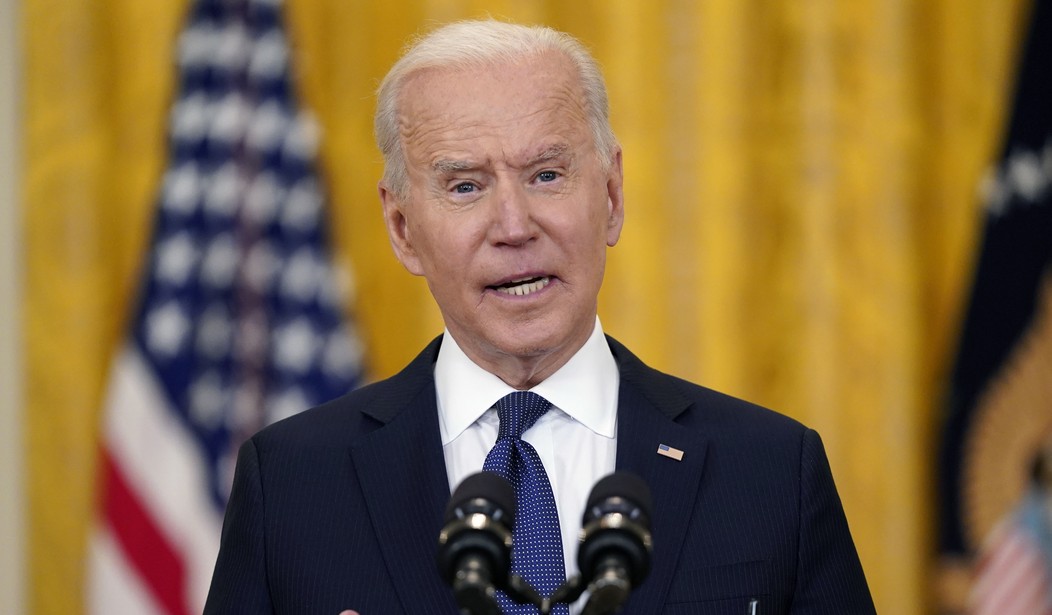The Associated Press calls this “solid” growth, but economists expected much more — especially with the amount of cash Congress and Joe Biden pushed into the economy. Growth hit an annualized GDP rate of 6.5%, adding to the also-less-than-stunning 6.3% expansion in Q1 following a relief package at the beginning of that period as well:
Real gross domestic product (GDP) increased at an annual rate of 6.5 percent in the second quarter of 2021 (table 1), according to the “advance” estimate released by the Bureau of Economic Analysis. In the first quarter, real GDP increased 6.3 percent (revised).
The GDP estimate released today is based on source data that are incomplete or subject to further revision by the source agency (see “Source Data for the Advance Estimate” on page 3). The “second” estimate for the second quarter, based on more complete data, will be released on August 26, 2021.
The increase in real GDP in the second quarter reflected increases in personal consumption expenditures (PCE), nonresidential fixed investment, exports, and state and local government spending that were partly offset by decreases in private inventory investment, residential fixed investment, and federal government spending. Imports, which are a subtraction in the calculation of GDP, increased (table 2).
Economists expected a growth rate of 8.4% in Q2, given that Biden and Congress spent $1.9 trillion of relief money beginning in March. Even the 6.5% growth rate looks a little worse once you get under the hood. Despite all of the cash that flowed into the economy, wages and disposable income dropped sharply, in part because the direct relief payments went out before the start of the quarter:
Current-dollar personal income decreased $1.32 trillion in the second quarter, or 22.0 percent, in contrast to an increase of $2.33 trillion (revised), or 56.8 percent, in the first quarter. The decrease primarily reflected a decrease in government social benefits related to pandemic relief programs, notably the decrease in direct economic impact payments to households established by the Coronavirus Response and Relief Supplemental Appropriations Act and the American Rescue Plan Act (table 8). Additional information on factors impacting personal income can be found in Effects of Selected Federal Pandemic Response Programs on Personal Income.
Disposable personal income decreased $1.42 trillion, or 26.1 percent, in the second quarter, in contrast to an increase of $2.27 trillion, or 63.7 percent (revised), in the first quarter. Real disposable personal income decreased 30.6 percent, in contrast to an increase of 57.6 percent.
Consumer spending remained on fire, clearly goosed by the relief payments from December and March. Personal consumption expenditures increased 11.8% over Q1, which itself showed an increase of 11.4%. However, business investment dropped 3.5% after dropping in Q1 by 2.3%, a bad sign for future growth.
Another surprising result: Residential construction investment dropped 9.8% after an increase of 13.3% in Q1. Given the heat from real estate markets, it’s surprising to see such a drop in investment for new homes. It’s either a sign that home buying might be cooling off, or that inflation based on supply shortages for building materials is squelching production. Either way, it’s not a great sign.
One improvement from Q1 is in the export/import balance. Imports still outstrip exports, but the gap from Q1 (-2.9%/9.3%) has narrowed (6.0%/7.8%). Imports are still growing faster than exports, which holds down the GDP growth rate, but that’s a much smaller factor in this report.
Another concern could be inventory exhaustion. Final sales of domestic product rose 7.7%, more than a full point above the topline GDP growth rate, indicating a drawdown of inventory. That follows a more dramatic gap in Q1 of 9.1% against that quarter’s 6.3% topline. Normally that would indicate incentives to accelerate production, but at this point the US has too many labor and material shortages to expect to respond. As inventory depletes in this environment, the most immediate result will be inflation rather than production, and inflation will erode real growth.
The Wall Street Journal reminds everyone of the inflation risks too:
Second-quarter growth fell short of economists’ forecasts. Economists surveyed by The Wall Street Journal estimated that gross domestic product, the broadest measure of goods and services made in the U.S., grew at an 8.4% annual rate in the April-to-June period.
Still, the growth propelled GDP beyond pre-pandemic levels, a milestone that underscores the speed of the recovery that began last summer. Widespread business reopenings, vaccinations and a big infusion of government pandemic aid this spring helped propel rapid gains in consumer spending, the economy’s main driver. …
Consumer prices rose 5.4% in June from a year before, the fastest pace since 2008, the Labor Department reported. As overall economic growth eases, price increases could cool as well. Economists surveyed by The Wall Street Journal in July see inflation measured by the department’s consumer-price index easing later this year, to 4.1% in December from a year earlier, and 2.5% by the end of 2022.
A slowdown in growth carries upsides, economists say. As demand moderates, firms will have more time to work through order backlogs and increase production. Many economists say inventory replenishment should boost output in the coming quarters.
Maaaayyyybeeee, but inflation creates reluctance to consume too. Right now, massive consumer spending is keeping this economy from gassing out, and the inventory exhaustion might bring that to a halt. You can’t replenish inventory without the materials to do it, and you can’t keep prices down when the costs of those materials are going through the roof. Until we resolve the labor shortage created by the perverse incentives of the pandemic unemployment benefit program, we won’t resolve any of that. And all of that will have a big impact on PCEs, now that the government has stopped boosting consumption through helicopter-cash deluges.








Join the conversation as a VIP Member